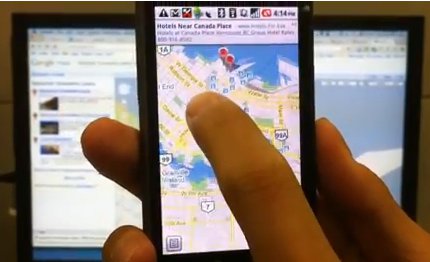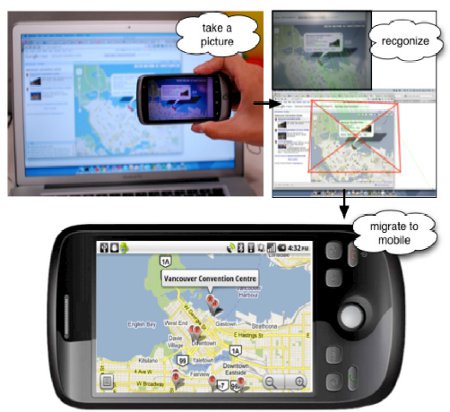App uses smartphone cameras for intelligent task transfers
Jun 24, 2011 — by LinuxDevices Staff — from the LinuxDevices Archive — viewsMIT (Massachusetts Institute of Technology) and Google have devised a method of transferring tasks between your smartphone and your computer by merely pointing the cellphone camera at your PC's screen. “Deep Shot” uses pattern recognition and an extended version of a standard URI (universal resource identifier).
How many times have you found a web page on your smartphone that you want open on your desktop computer? Or perhaps you were viewing your destination on Google Maps and want to transfer it to your smartphone. Using an experimental app called Deep Shot, you can do these things by merely aiming your smartphone's camera at your computer.

Deep Shot, shown here on an Android phone, is currently designed to work with Google Maps and Yelp
The app works by taking a photo of your computer's screen. Using pattern recognition algorithms, it ascertains what program you are currently running and the document you have open. It then transfers that information from the desktop computer to your smartphone.
In case you want to reverse the direction, the pattern recognition algorithm will ascertain which desktop computer the camera is pointed at and then transfer the currently open file on the smartphone to the desktop computer after opening the appropriate program there.

Deep Shot, pulling up a Google Maps screen from a desktop PC and displaying it on a smartphone, all via the camera
Source: MIT
(Click to enlarge)
Do not look to download the app just yet. This work is still in the proof-of-concept stage. To that end, the team has adapted several popular applications, including Google Maps and social networking and peer review site Yelp, to work with the app.
In order to use Deep Shot with other programs besides Yelp and Google Maps, application developers will have to develop the ability to read and write URI's. If the technology is commercialized by Google, possibly as part of the Google Goggles image recognition app, an API would have to be published by Google and adopted by other application developers.
"I find it a really compelling use case, so I would really hope that companies like Microsoft would really consider adding it," says Jeffrey Nichols, a researcher at IBM's Almaden research center who specializes in mobile devices. "I see it being much more likely to happen with websites than with desktop applications."
Nichols went on to add, "On the other hand, to some extent, we're moving away from desktop applications and moving more and more to the web, so it's not clear to me how important it is that we really bring all the native application developers into the fold."
MIT CSAIL demonstration of Deep Shot on YouTube
Source: MIT (Click to play)
More information on Deep Shot may be found in this MIT press release. Chang and Li's paper on Deep Shot may be found in this MIT CSAIL PDF file.
This story originally appeared in our sister publication Smarter Technology. The author's blog may be found here.
This article was originally published on LinuxDevices.com and has been donated to the open source community by QuinStreet Inc. Please visit LinuxToday.com for up-to-date news and articles about Linux and open source.